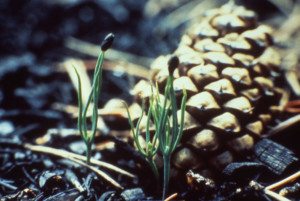Finding Balance in Black Carbon Emissions from Wildfires

Pine seedlings sprout after a fire in Yosemite National Park (Photo by Ann Deutch, National Park Service)
Black carbon is easy to villainize. After all, who likes soot? It’s also a greenhouse gas, that by some calculations[i], is 3,200 times more powerful than CO2. The black carbon emitted from burning coal, tailpipes, and wildland fires can also cause a range of human health impacts such as respiratory problems. California has been a world leader in reducing human-caused emissions from black carbon – with levels now 90% lower than they were in the early 1960s.[ii]
However, emissions from wildfires need to be considered differently from the human-caused sources of black carbon. California’s forests, woodlands, and grasslands are fire adapted, having evolved alongside fires that were caused by lighting or intentionally set by native Americans. For instance, some tree species have seeds that will only start growing after a fire.[iii] Many animals rely on the open patches in the forest created by fire to find food and habitat.
 The past policies of fire suppression haven’t worked – causing fuel to build up and creating conditions for more dangerous fires. Instead, we need regular low and moderate severity fires that burn out the underbrush. Restoring fire can also help reduce the risk of larger stand-destroying fires that have more serious human health implications. As California’s forests need more fires, eliminating the black carbon emissions from forest fires is neither a realistic nor desirable goal.
The past policies of fire suppression haven’t worked – causing fuel to build up and creating conditions for more dangerous fires. Instead, we need regular low and moderate severity fires that burn out the underbrush. Restoring fire can also help reduce the risk of larger stand-destroying fires that have more serious human health implications. As California’s forests need more fires, eliminating the black carbon emissions from forest fires is neither a realistic nor desirable goal.
We can look to the past to help set benchmarks for reasonable emissions of black carbon from forest fires. These historic levels can help inform how much fire is normal in natural conditions. Before European settlement, California’s wildland fires may have caused more than three times the black carbon emission than they do today.[iv] This historical level can be used as a baseline so that well-meaning policies don’t inadvertently limit the needed restoration of fire to California’s forests.
Read more: Our comments on California’s Short-Lived Climate Pollutant Strategy
[i] Since the lifetime of black carbon in the atmosphere is very short (days to weeks) there are different ways of calculating how its impact compares to carbon dioxide which can last in the atmosphere for hundreds of years. Over a twenty-year time period, the Global Warming Potential of a single molecule of black carbon is 3,200 times that of CO2. This is the equivalency that is used in California’s Air Resources Board Short-lived Climate Pollutant Strategy. However, under the other common metric used in the scientific community, the 100-year time frame, black carbon has a Global Warming Potential of 900 times that of CO2 (IPCC 2013).
[ii] Air Resources Board, 2017. Final Proposed Short-Lived Climate Pollutant Strategy https://www.arb.ca.gov/cc/shortlived/meetings/03142017/final_slcp_report.pdf
[iii] http://www.pbs.org/wnet/nature/giant-sequoia-needs-fire-grow/15094/
[iv] Pacific Forest Trust comments on California’s Short-Lived Climate Pollutant Strategy
